Main Article Content
Abstract
This paper is based on the traditional weaving as one of the handicrafts of the people in the area is believed to be able to take a role in it. The scope of tourism is chosen because tourism is an industrial sector that is quick yielding and opens up new opportunities for the tourism industry in the Lake Toba region, which has only focused on nature tourism. The approach used in this study is a Cultural Resources Management (CRM) with the mindset that traditional weaving and inheritance aspects are aimed at empowering the economy in order to provide sustainable community benefits. The analysis was carried out qualitatively with an ethnographic study approach. This study seeks to see and reveal whether traditional weaving-based cultural tourism has economic value, because it contains the concept of preservation and cultural inheritance, economics, education, and based on community empowerment. This research also see the weaving potential mapped in its distribution correlated with tourist objects that have been seeded by the North Tapanuli Regional Government resulting in clusters that can be developed into tourism packages oriented to market demand, without ignoring the empowerment of local communities. Although weaving is believed to be able to increase the tourism market in Sibandang Island, there are still a number of obstacles, namely in the fields of promotion, strengthening of weaving crafts, and the creation of tourism conscious communities. The root of the problem of the three obstacles is the lack of public awareness of the Ulos Sibandang weaving as one of the cultural artifacts that has been passed down for hundreds of years.
Keywords : cultural tourism, ecosystems, traditional weaving, Cultural Resources Management
